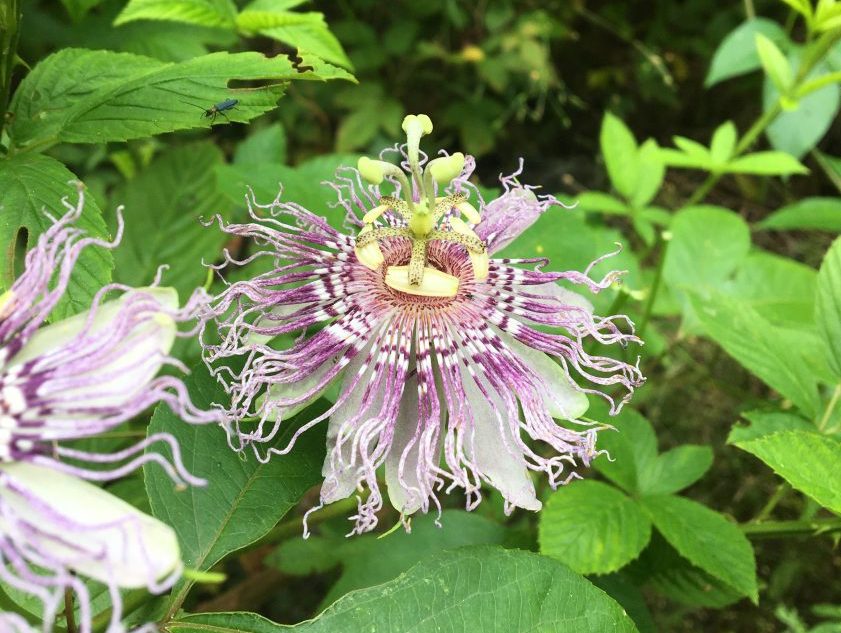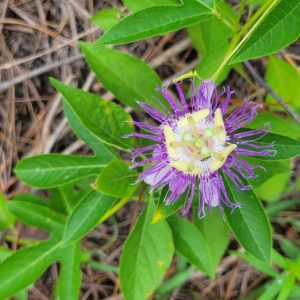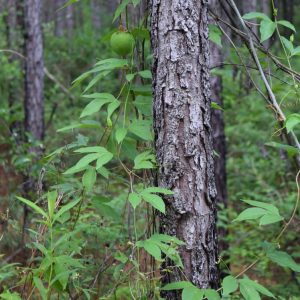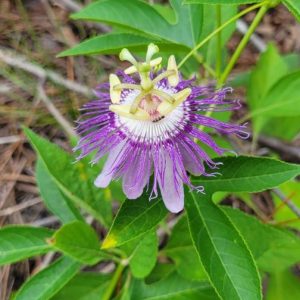Forestry

General Description
Maypop (Passiflora incarnata)–also known as the purple passion flower–is a widespread native vine in the passion flower family. It occurs almost everywhere in Alabama and grows in a wide variety of conditions. This herbaceous perennial grows from rhizomes to about 8 feet in length. It has alternate leaves with three lobes and climbs with tendrils.
Maypop flowers are large and showy and have a ring of white and purple or blueish filaments over paler petals with prominent central stamens (the pollen-bearing parts of a flower). The plant also produces extrafloral nectaries at the base of its leaves, and these structures produce nectar outside of the flowers. The fruit is approximately the size of a chicken egg and is pale green when unripe but ripens to a yellowish-green or yellowish-orange color by late summer. The outer rind is thick and spongy, while the flesh is extremely gelatinous around the many seeds. When ripe, the flesh and seeds are often loose and unattached to the interior of the fruit.
Uses for People
Maypop fruit has been used by Native Americans as a food source for thousands of years. The pulp of maypop fruit is sweet and tangy and becomes extremely sweet when the fruit is ripe or overripe. One cup of maypop juice is a good source of vitamin A (1770 international units), potassium (687 milligrams), magnesium (42 milligrams), vitamin C (73 milligrams), and fiber (0.5 grams). The juice can be added to other juices or drinks. It can also be made into jams, jellies, frosting, ice cream, and pastry filling. Recipes that work well for passion fruit should work well for this species. While the pulp is good to eat, the seeds can be strongly sour or bitter. It is best to strained the seeds out.
The perennial nature and exotic appearance of the maypop vine, as well as its large and beautiful flowers, make it an excellent ornamental along fences or trellising.
Uses for Wildlife
Many animal species consume maypop fruit. Also, the plants flowers and extrafloral nectaries are visited by a wide range of pollinating and nectar-feeding insects and possibly hummingbirds as well. The foliage of this species–and other native passion flowers–is the primary food source for many butterfly species, including the Gulf fritillary and zebra longwing.
Cultivation
Whether sourced from retailers or from the wild, maypop is relatively easy to cultivate and propagate. It can be grown from root cuttings or from seeds, though root cuttings are faster and more reliable if available. It will thrive in soil of moderate quality and moisture and has good growth and fruit production when grown in full sun. In ideal conditions, it can be somewhat aggressive and may need to be pruned back or have the suckers removed to limit its spread. A moderate amount of watering and fertilization may be needed during drought or in poor soil conditions. Mulching around the base of the plant will reduce weed competition, help keep the roots cool, and assist with water retention.
If purchasing seeds or plants online or from a nursery, take care to buy only the native P. incarnata. Many tropical relatives of maypop are grown as ornamentals or for their edible fruit. One species–the true passion fruit (P. edulis)–could potentially become invasive in the southernmost parts of Alabama. It would be killed by frost in the northern parts of the state.
Under normal conditions, maypop will do well and have relatively low pest or disease pressures and is resistant to deer. However, it is possible for large numbers of butterflies to lay eggs on a single plant, and excessive caterpillar pressures can result in near-complete defoliation and poor or nonexistent fruiting. It can also be heavily attacked by Japanese beetles where they occur in numbers. The extrafloral nectaries may attract ants. While they will not harm the plant, it could be an issue for those sensitive to bites or stings.




